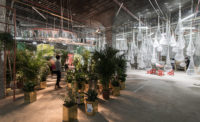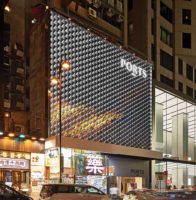Hong Kong
Hosting a dinner for 2,000 senior citizens or teaching 200 children to plant a garden is not most people’s idea of what constitutes architecture. But for Marisa Yiu and Eric Schuldenfrei of the Hong Kong firm ESKYIU, that’s precisely the point. “It was about testing the limits of our audience,” says Yiu of these and other events that helped to make up the 2009 Hong Kong & Shenzhen Bi-City Biennale of Urbanism\ Architecture, which she oversaw as chief curator. “We’re interested in architecture that’s not just about buildings per se,” says Schuldenfrei, “but how architecture affects the society around it.”
Hong Kong–raised Yiu and American-born Schuldenfrei met at Princeton’s architecture school and formed ESKYIU in 2005 as part of a generation of emerging designers who emphasize architecture as a social, cultural, and curatorial practice. While the husband-and-wife pair have also explored form and fabrication—with a futuristic stage set for movement artist Ido Portal, for example—they see architecture as less a matter of bricks and mortar than about connecting what happens inside a building to the community and world outside. In addition to the 2009 biennale, which took the do-it-yourself theme of “B.Y.O.B.” (Bring Your Own Biennale), Yiu, 38, and Schuldenfrei, 40, have mounted an interactive art piece made of metal “bamboo” on the roof terrace of an arts center in a formerly industrial neighborhood of Hong Kong; designed an installation of aquatic plants and “conceptual fishing reefs” to promote marine sustainability; and organized a bevy of talks and workshops tackling topics from cross-border issues in the Pearl River Delta region to the future of architectural education.
Though it can seem that Yiu and Schuldenfrei, who also teach at The Chinese University of Hong Kong and University of Hong Kong, respectively, do everything other than architecture proper, it’s not that they don’t want to build. “That’s something we’re, of course, very interested in,” says Schuldenfrei, whose involvements include architecture as a communications medium. (He has a book coming out on the films of Charles and Ray Eames.) But the profession is notorious for making designers wait eons before giving them substantial opportunities to build. And while the “paper” architects of the 1970s may have bided their time contemplating theoretical and practical applications of the grid, Yiu and Schuldenfrei are happy, for now, working in the public realm of socially oriented experiments.
In this respect, and in their work across disciplines, they can be seen as part of a broader cultural phenomenon that spans from relational aesthetics (which ties art to social interactions) to the current beyond-the- object emphasis on “social innovation” in design. It’s a way of thinking that sees spaces and objects as a means more than an end. For ESKYIU, this notion is manifesting itself in forthcoming projects such as public installations for an aquarium, a mass-transit hub, and a contemporary teahouse where they are designing everything from the interior to the programming and events. “Design isn’t just about the static state of something at the time it’s built, but how it changes over time,” says Schuldenfrei. Adds Yiu: “We want to open architecture up and find more ways for people to participate.”
ESKYIU
FOUNDED: 2005
DESIGN STAFF: 5
PRINCIPALS: Marisa Yiu and Eric Schuldenfrei
EDUCATION: Yiu: Princeton, M.Arch., 2001; Columbia, B.A., 1998. Schuldenfrei: University of Cambridge, Ph.D., 2011, M.Phil, 2005; Cornell, B.Arch., 1999
WORK HISTORY: Yiu: KPF, 2001–05; Marble Fairbanks, 1997–98. Schuldenfrei: Eric Schuldenfrei Animation: Art + Architecture, 2003–05
KEY COMPLETED PROJECTS: POP-UP Studio-X, Shenzhen, China, 2013; Industrial Forest, Hong Kong, 2013; Ido Portal, Hong Kong, 2012
KEY CURRENT PROJECTS: The Tea Academics Café, HK, 2014; Ocean Architecture Aquarium, HK, 2015; MTR Public Art Installation, HK, 2016; Orochen Museum, Inner Mongolia, China, 2017
WEBSITE: WWW.ESKYIU.COM
People |
Products |





















Post a comment to this article
Report Abusive Comment